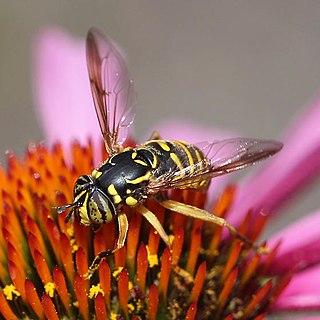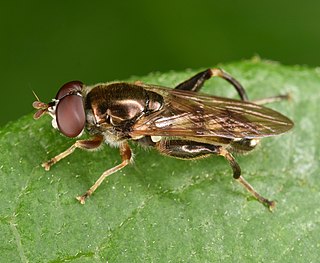
Spilomyia citima, the Western Hornet Fly, is a rare species of syrphid fly first officially described by Vockeroth in 1958. Hoverflies get their names from the ability to remain nearly motionless while in flight. The adults are also known as flower flies for they are commonly found around and on flowers, from which they get both energy-giving nectar and protein-rich pollen. The larvae are known as the short-tailed larvae suited for moist areas such as rot holes of trees.

Somula is a genus of syrphid flies in the family Syrphidae. There are at least two described species in Somula.
Milesia bella is a species of hoverfly in the family Syrphidae.

Chalcosyrphus (Xylotomima) plesia, the Black-hipped Leafwalker, is an uncommon species of syrphid fly and a mimic of Sphex nudus. This fly is found in the northeastern United States and southeastern Canada. Hoverflies can remain nearly motionless while in flight. The adults are also known as flower flies for they are commonly found around and on flowers, from which they get both energy-giving nectar and protein-rich pollen.

Eristalis dimidiata, the black-shouldered drone fly, is a species of hoverfly native to much of Canada and the eastern and northern United States. It flies year-round in southern areas and from late March to mid-November further north. It is one of the earliest hoverflies to fly in the spring, and as such likely overwinters as an adult. It lives primarily in forests.
Milesia scutellata is a species of hoverfly in the family Syrphidae.

Chalcosyrphus (Xylotomima) metallicus, the Yellow-legged Leafwalker, is an uncommon species of syrphid fly observed in the southeastern United States. Hoverflies are able to remain nearly motionless while in flight. The adults are also known as flower flies for they are commonly found around and on flowers, from which they get both energy-giving nectar and protein-rich pollen.
Spilomyia foxleei is a species of syrphid fly in the family Syrphidae.

Criorhina caudata is a species of hoverfly in the family Syrphidae.
Blera nigripes is a species of hoverfly in the family Syrphidae.

Chalcosyrphus depressus the Wide-eyed Leafwalker, is a rare species of syrphid fly observed from Idaho and Montana. Hoverflies can remain nearly motionless in flight. The adults are also known as flower flies for they are commonly found on flowers, from which they get both energy-giving nectar and protein-rich pollen.
Criorhina latipilosa is a species of hoverfly in the family Syrphidae.
Criorhina villosa is a species of hoverfly in the family Syrphidae, formerly placed into its own genus, Merapioidus. Its name has been confused with the name of a related species from Mexico, which was originally described as Romaleosyrphus villosus, and published in 1882; as the two species are now both placed in the same genus, Criorhina, only the older of the two names can remain as Criorhina villosa, and the 1882 name will need to be replaced.
Spilomyia pleuralis is a species of Hoverfly in the family Syrphidae.
Spilomyia ephippium is a species of Hoverfly in the family Syrphidae.
Xylota azurea is a species of hoverfly in the family Syrphidae.
Xylota lovetti is a species of hoverfly in the family Syrphidae.
Xylota nebulosa is a species of hoverfly in the family Syrphidae.
Xylota nitidula is a species of hoverfly in the family Syrphidae.
Xylota willistoni is a species of hoverfly in the family Syrphidae.






